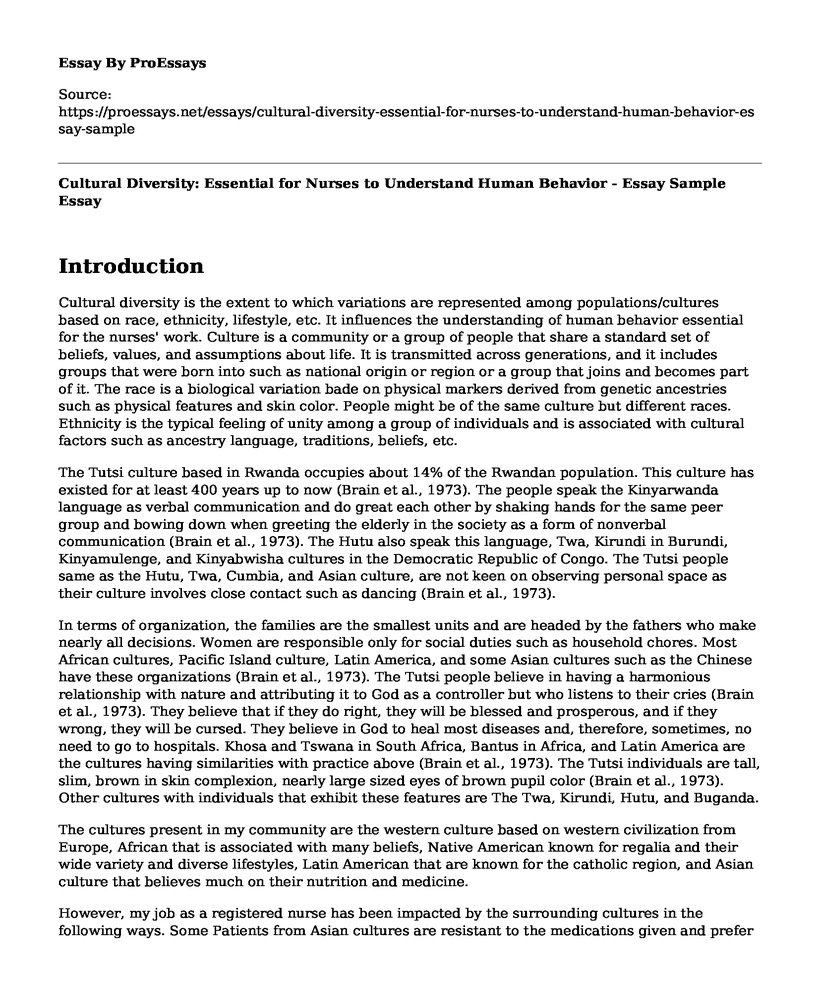Introduction
Cultural diversity is the extent to which variations are represented among populations/cultures based on race, ethnicity, lifestyle, etc. It influences the understanding of human behavior essential for the nurses' work. Culture is a community or a group of people that share a standard set of beliefs, values, and assumptions about life. It is transmitted across generations, and it includes groups that were born into such as national origin or region or a group that joins and becomes part of it. The race is a biological variation bade on physical markers derived from genetic ancestries such as physical features and skin color. People might be of the same culture but different races. Ethnicity is the typical feeling of unity among a group of individuals and is associated with cultural factors such as ancestry language, traditions, beliefs, etc.
The Tutsi culture based in Rwanda occupies about 14% of the Rwandan population. This culture has existed for at least 400 years up to now (Brain et al., 1973). The people speak the Kinyarwanda language as verbal communication and do great each other by shaking hands for the same peer group and bowing down when greeting the elderly in the society as a form of nonverbal communication (Brain et al., 1973). The Hutu also speak this language, Twa, Kirundi in Burundi, Kinyamulenge, and Kinyabwisha cultures in the Democratic Republic of Congo. The Tutsi people same as the Hutu, Twa, Cumbia, and Asian culture, are not keen on observing personal space as their culture involves close contact such as dancing (Brain et al., 1973).
In terms of organization, the families are the smallest units and are headed by the fathers who make nearly all decisions. Women are responsible only for social duties such as household chores. Most African cultures, Pacific Island culture, Latin America, and some Asian cultures such as the Chinese have these organizations (Brain et al., 1973). The Tutsi people believe in having a harmonious relationship with nature and attributing it to God as a controller but who listens to their cries (Brain et al., 1973). They believe that if they do right, they will be blessed and prosperous, and if they wrong, they will be cursed. They believe in God to heal most diseases and, therefore, sometimes, no need to go to hospitals. Khosa and Tswana in South Africa, Bantus in Africa, and Latin America are the cultures having similarities with practice above (Brain et al., 1973). The Tutsi individuals are tall, slim, brown in skin complexion, nearly large sized eyes of brown pupil color (Brain et al., 1973). Other cultures with individuals that exhibit these features are The Twa, Kirundi, Hutu, and Buganda.
The cultures present in my community are the western culture based on western civilization from Europe, African that is associated with many beliefs, Native American known for regalia and their wide variety and diverse lifestyles, Latin American that are known for the catholic region, and Asian culture that believes much on their nutrition and medicine.
However, my job as a registered nurse has been impacted by the surrounding cultures in the following ways. Some Patients from Asian cultures are resistant to the medications given and prefer to use their traditionally made. When advised to take the recommended foods as per diet health requirements, they only want their cultural foods (Haller et al., 2019). African culture patients’ beliefs such as a believing on nature to heal and curses and unreceptiveness to some of the technologies undermine my rating as a registered nurse since it is a requirement to save as many lives as possible which in this belief becomes difficult (Haller et al., 2019). Native American culture, western culture, and Latin American culture patients have made my work easy as they are not that locked into the culture, plus their culture is associated with the current trends (Haller et al., 2019).
References
Brain, J. L. (1973). The Tutsi and the Ha: a study in integration. Journal of Asian and African Studies, 8(1-2), 39-49. https://brill.com/view/journals/jaas/8/1-2/article-p39_4.xml?language=en
Haller, P. M., Naegele, U., & Berger, S. (2019). Cultures of Our World. In Bridging Cultural Barriers (pp. 75-226). Springer, Cham. https://link.springer.com/chapter/10.1007%2F978-3-030-17130-8_3
Cite this page
Cultural Diversity: Essential for Nurses to Understand Human Behavior - Essay Sample. (2023, Aug 21). Retrieved from https://proessays.net/essays/cultural-diversity-essential-for-nurses-to-understand-human-behavior-essay-sample
If you are the original author of this essay and no longer wish to have it published on the ProEssays website, please click below to request its removal:
- The Song of Dynasty and Chinese Culture in the United States
- Essay Example on the Humanities: My Online Museum Visit
- Arabic Versus Asian Culture Essay
- Reading Festival Reflective Essay
- Essay Example on Authenticity in I Am Not Your Perfect Mexican Daughter by Ericka Sanchez
- Essay Example on Coronavirus: Impact on Ethnicity & Cultural Diversity?
- Cultural Experience Field Report







